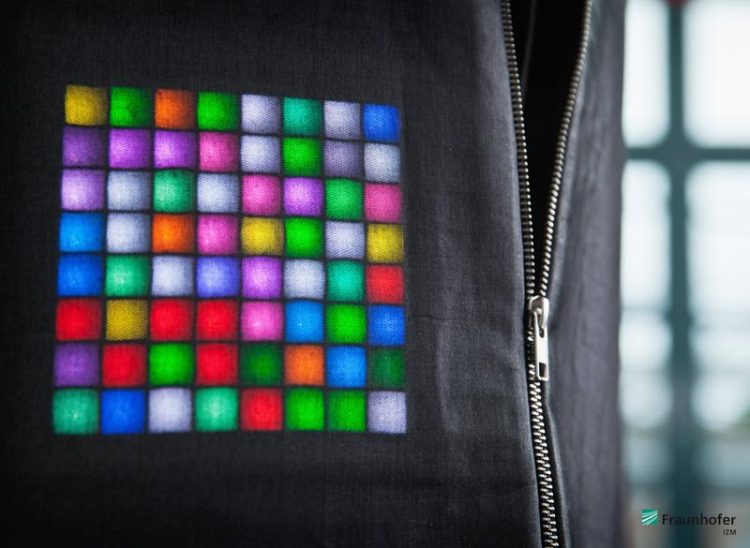From intelligent knee braces to anti-theft backpacks

Coat with fully integrated 64 smart pixel in-fabric display Volker Mai / Fraunhofer IZM
Integrating electronic assemblies can level up the capabilities of textiles with many versatile functions, from monitoring to lighting and beyond. With 15 years of expertise in the field, the Fraunhofer IZM has created a universe of innovative applications for textiles. The 10th Wearable Technologies Conference 2016 in Munich (ICM, booth 32) will showcase some of the highlights.
The expo will premier a textile stretch sensor for soft knee braces. The on-going MOTEX research project has led to the development of a stretchable fabric that can track the flexion of the brace with exceptional precision.
The technology is particularly promising for patients with artificial knee joints: The innovative system notices any unnecessary or unhealthy movements or friction, and can notify the patient or surgeon immediately via cloud or smartphone connection, The sensor concept and miniature monitoring technology was developed by Fraunhofer IZM in collaboration with the Belgian research institutes Centexbel and Mobilab.
Similar technologies are being used in highly flexible and deformable LED displays. The 7-segment display developed as part of the SINETRA project is intended to provide optical warning signals in extreme environments, with possible applications including the protective gear worn by firemen.
These displays employ Stretchable Circuit Boards (SCB) made from polyurethane, keeping the often irreconcilable worlds of textile and electronics production separate until the very final stage, when the laundry and ironing-proof electronics are laminated onto the host fabric – in this case fleece.
Textile integration technologies also pave the way for a versatile range of security applications. The Fraunhofer IZM has teamed up with the Austrian company Skarabeos to introduce to the world the prototype of a backpack that can actively prevent pickpocketing.
A sensor integrated into the fabric itself sets off an alarm before the backpack is opened by those with criminal intent. The sensor can also use Bluetooth to hook up with an application on the wearer’s smartphone and execute location-based actions, such as locking the bag in areas known as pickpocketing hotspots.
The spotlight will also fall on one guaranteed eye-catcher: a jacket with textile-integrated displays that can change colour and pattern or act as a dynamic medium to display information. Conventional display matrixes are typically controlled with highly complex wiring.
This cannot be replicated when using textile fabrics, as current production processes would not allow the precision required for the purpose. The solution is provided by I²C busses that use just four conductors to establish a parallel connection of the Smart Pixels.
The Smart Pixels are miniature circuit boards mounted with a RGB LED and four passive SMD modules. Embedding technology is used to integrate the backbone of each pixel – I²C bus LED drivers in a QFN package – in the circuit board. The tiny form factor of the Smart Pixels keeps the host fabric as soft and flexible as it should be.
Visitors can experience all of these prototypes from up close in the expo area of the 10th Wearable Technologies Conference 2016 in Munich (ICM, booth 32).
http://www.izm.fraunhofer.de/en/news_events/tech_news/fraunhofer-izm-zeigt-live-…
Media Contact
All latest news from the category: Event News
Newest articles

High-energy-density aqueous battery based on halogen multi-electron transfer
Traditional non-aqueous lithium-ion batteries have a high energy density, but their safety is compromised due to the flammable organic electrolytes they utilize. Aqueous batteries use water as the solvent for…

First-ever combined heart pump and pig kidney transplant
…gives new hope to patient with terminal illness. Surgeons at NYU Langone Health performed the first-ever combined mechanical heart pump and gene-edited pig kidney transplant surgery in a 54-year-old woman…

Biophysics: Testing how well biomarkers work
LMU researchers have developed a method to determine how reliably target proteins can be labeled using super-resolution fluorescence microscopy. Modern microscopy techniques make it possible to examine the inner workings…





















